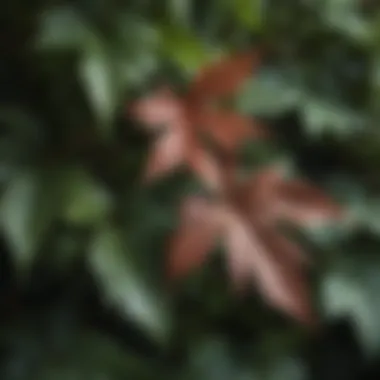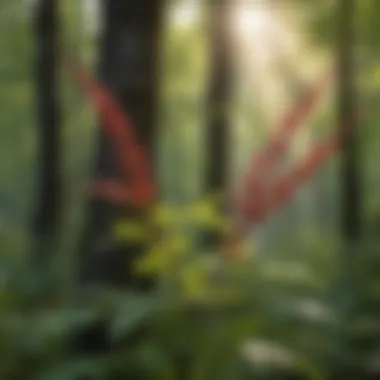Plants That Look Similar to Poison Ivy: An In-Depth Analysis


Intro
Understanding the similarities and differences between various plant species greatly enhances our safety and knowledge as we explore natural environments. One plant that poses potential hazards is poison ivy. Because of its ability to cause severe allergic reactions in various individuals, being able to identify it is of utmost importance. Many plants, however, can easily resemble poison ivy, making identification challenging for the untrained observer.
This article will delve into various species that closely mimic poison ivy’s appearance. Each plant will be examined for its visual characteristics, preferred habitats, and implications for human interaction. Engaging with this information can create a foundational knowledge that promotes safer navigation through woodlands and increases our understanding of local biodiversity.
Forest Ecology and Biodiversity
Importance of Forest Ecosystems
Forests are pivotal to maintaining ecological balance. They provide habitat to countless species and play a significant role in carbon sequestration. By understanding the flora present in these ecosystems, including plants that look similar to poison ivy, we gain insights into larger ecological functions.
Flora and Fauna in Woodlands
Woodlands host a diverse array of plant species alongside their animal counterparts. This biodiversity promotes resilience in forest ecosystems. For example, Virginia creeper shares a habitat with poison ivy but is non-toxic. Being able to distinguish between these plants safeguards us and supports ecological balance.
"Biodiversity is the foundation of ecosystem services, including food and clean water." – Global Biodiversity Outlook
Identifying non-toxic plants, such as Virginia creeper, helps build a rich understanding of ecological interactions. Knowledge of these relationships cultivates awareness of the myriad species surrounding us.
Similar Plants to Poison Ivy
Several plant species bear resemblance to poison ivy, and learning their key traits aids in proper identification.
Virginia Creeper
- Five leaflets per stem.
- Tends to have a climbing growth habit.
- Leaves are more serrated than poison ivy.
Boxelder
- Compound leaves, often with 3-5 leaflets.
- Frequently found near water sources.
- Can develop into small trees.
Oak Seedlings
- Young oaks often appear similar in leaf arrangement.
- Leaves may be lobed or unlobed.
- Typically found in similar habitats as poison ivy.
These look-alikes contribute to the need for heightened awareness in woodlands. Misidentification can lead to unnecessary reactions or avoidance of safe plants.
Epilogue
Knowledge of plants similar to poison ivy allows for informed decisions in outdoor pursuits. By understanding the characteristics, habitats, and implications of these species, we promote a culture of safety and responsibility in nature.
Engaging with local ecosystems can deepen our appreciation and urge effective stewardship. Knowing what to look for, and understanding the broader ecological context, not only protects individuals but also fosters respect for the environment.
Prologue to Poison Ivy
Understanding poison ivy is critical not only for personal safety but also for ecological awareness. Poison ivy is a significant concern in many regions, especially for those who spend time outdoors. Knowledge about this plant can prevent allergic reactions, thus ensuring safer interactions with nature. Furthermore, recognizing poison ivy contributes to understanding the myriad of plant species and their roles in local ecosystems.
Understanding Poison Ivy
Poison ivy, scientifically known as Toxicodendron radicans, is a perennial plant found across North America. Its distinctive feature is the composition of leaves, which typically appear in clusters of three. The foliage can vary in shape and texture, ranging from glossy to dull and can exhibit a range of colors from green in the summer to vibrant reds and oranges in the fall. The plant can grow as a climbing vine, shrub, or ground cover depending on the environment. Identifying poison ivy accurately is crucial, as misidentifications can lead to painful skin reactions.
The ability to recognize poison ivy is vital for both casual hikers and forest professionals. Being adept at recognizing this plant helps prevent encounters that could lead to severe discomfort, thereby promoting a more enjoyable outdoor experience.
Toxicity and Reactions


The sap of poison ivy contains an oil called urushiol, which is responsible for most of the allergic reactions associated with the plant. When the oil comes into contact with skin, it can cause rashes, blisters, and intense itching. These reactions can vary significantly among individuals, with some experiencing mild discomfort while others face severe responses. The impact of urushiol can be drastic; even indirect contact, such as touching clothing or pets that have brushed against the plant, can trigger a reaction.
"A contact with the plant can result in dermatitis, which might last for weeks if not treated properly."
To mitigate these effects, it is essential to understand how to recognize poison ivy and its surroundings. Immediate washing with soap and water after suspected exposure is a recommended practice to limit the reaction.
In summary, understanding poison ivy encompasses recognizing its physical attributes and knowing the potential health implications associated with it. This knowledge is crucial for anyone engaging with outdoor environments, helping to cultivate a safer and more informed approach to nature.
Importance of Recognition
Understanding the significance of recognizing plants that resemble poison ivy is crucial for anyone venturing into outdoor environments. Poison ivy, known for its notorious skin reactions, can easily be mistaken for other plant species. Identifying these look-alikes accurately can reduce the risk of allergic reactions and promote safer navigation in natural settings.
Preventing Allergic Reactions
The primary concern when it comes to plant look-alikes is the potential for allergic reactions. Poison ivy contains an oil called urushiol, which is responsible for the uncomfortable rashes it can cause upon contact. Many individuals have varying sensitivity to this compound. Consequently, misidentifying poison ivy can lead to accidental exposure. By being aware of plants that share similar characteristics with poison ivy, like Virginia creeper or poison oak, people can take precautions to avoid contact.
Educators and professionals in forestry can benefit from awareness of these similarities. Training sessions can help individuals recognize the specific features of poison ivy compared to other plants. For example, poison ivy typically has three leaflets, but so do some non-toxic species. Knowledge about leaf shape and arrangement can be vital in distinguishing safe from unsafe plants in the field. This knowledge empowers outdoor enthusiasts to make informed decisions, ultimately reducing the risk for allergic reactions.
Ecological Implications
Beyond personal health, recognizing plants that look like poison ivy has broader ecological implications. Many species that resemble poison ivy fulfill essential roles in their ecosystems. For instance, creating a balanced habitat requires understanding how various plants support local wildlife. Some look-alikes may provide food or shelter for specific animals.
It’s important to educate the public about the ecological value of these plants. For example, Virginia creeper offers food sources for birds and insects throughout different seasons. By helping individuals understand these relationships, we can promote the conservation of native plant species rather than unnecessary removal.
Species misidentification may lead to unintended consequences. Removing a seemingly harmful plant like poison oak might obliterate essential flora that contributes to ecological health. Therefore, fostering recognition of such plants aids not only in individual safety but also in sustaining biodiversity.
"Proper identification of plants can serve as a safeguard against potential health issues and contribute positively to ecological understanding."
Overall, being aware and educated about plants resembling poison ivy is essential. It ensures safety, fosters environmental stewardship, and promotes harmony with nature.
Plants That Resemble Poison Ivy
Recognizing plants that resemble poison ivy is vital for safety in natural environments. Knowing these look-alikes helps ensure that individuals can navigate woodlands without facing allergic reactions. Additionally, understanding the similarities among these plants can aid in ecological education and the promotion of biodiversity. Each species discussed below showcases unique attributes that must be distinguished from poison ivy, clearly demonstrating their importance in both human interaction and ecosystem health.
Virginia Creeper
Identification Features
Virginia creeper, with its distinctive five-leaf clusters, is often mistaken for poison ivy due to its similar growth habits. The key characteristic of this plant is its vibrant green leaves which turn reddish in the fall. This plant's recognized feature, its climbing ability, allows it to thrive in various habitats, which makes it an interesting inclusion in this discussion. Understanding these identifying features can prevent misidentification and potential exposure to poison ivy.
Cultural Significance
Virginia creeper holds various meanings in different cultures. It is known to be used in traditional medicine for its purported health benefits, which adds to its cultural relevance. Its ability to cover walls and structures also makes it a popular choice for landscaping, as it provides aesthetic value. This unique feature of being an ornamental plant is beneficial for enhancing outdoor spaces, though caution should remain to avoid confusion with toxic species.
Habitat and Distribution
This species is commonly found in North America, preferring well-drained soils and the edges of forests. Virginia creeper’s distribution extends from southern Canada down to Mexico, adapting well to a range of environments. Its broad habitat range ensures it plays a role in various ecosystems by providing cover and food for wildlife. This adaptability is beneficial for conservation and local ecology, though care should be taken in agricultural contexts where it can become invasive.
Box Elder
Leaf Characteristics
Box elder leaves are typically arranged oppositely and possess a variable leaf shape that can lead to confusion with poison ivy. The key defining feature is the compound leaf with three to five leaflets. This complexity can complicate identification but makes the species interesting. Recognizing such traits can help avoid dangerous contact with poison ivy when in the field.
Common Misidentifications


Often, box elder is misidentified due to its societal presence. Many people see it in neighborhoods without realizing its resemblance to toxic plants. This can result in unnecessary anxiety around outdoor activities. Understanding its unique characteristics can reduce the chances of mistaking it for poison ivy, as well as emphasizing the need for education on local flora.
Ecological Role
Box elder trees are significant within their ecosystems, offering shelter and food for various birds and insects. As they grow near water bodies, they also stabilize soil and contribute to water quality. This ecological role benefits the surrounding environment but pushes the need for proper identification to manage biodiversity effectively.
Wild Grape
Visual Similarities
Wild grape shares similar growth patterns with poison ivy, often growing in tangled masses. The characteristic dark green leaves can look just like poison ivy’s in certain contexts. While the leaves are lobed, their edges are less pronounced. Understanding these visual similarities will fortify identification skills for the discerning observer.
Grape Varieties
Numerous varieties of wild grapes exist across North America. Understanding these grape types can enhance knowledge of local flora. Different species possess distinct flowers and fruit, which help distinguish them from poison ivy. This diversity among grape varieties emphasizes local biodiversity, which is essential for healthy ecosystems.
Growth Patterns
Wild grape plants demonstrate vigorous growth, often climbing trees and structures. This rapid growth allows them to dominate certain areas, which could obscure the presence of less vigorous species. Understanding their growth patterns is crucial for effective management in both gardens and natural settings. Grapes can also produce edible fruits, which serve as a food source for wildlife, contributing to their ecological importance.
Poison Oak
Distinguishing Features
Poison oak has leaf structures resembling both that of poison ivy and Virginia creeper. Leaf edges and count can vary, with most leaves possessing three lobes. Its distinguishing feature is the hairy texture, compared to the smoother feel of poison ivy leaves. Recognizing these traits is essential for anyone who spends time in affected areas, reducing risks of allergic reactions.
Geographical Range
This species is primarily found in the western United States. It thrives in forests, scrublands, and disturbed areas. Its geographic range overlaps that of poison ivy, making proper identification even more critical for outdoor enthusiasts. Knowing where to expect poison oak can help individuals avoid contact and facilitate safer exploration of natural areas.
Allergic Considerations
Like poison ivy, poison oak contains urushiol, a compound that causes skin irritations. Understanding the allergic potential of poison oak is paramount for outdoor activities. Education and awareness about its potential impact can help individuals remain safe while enjoying nature, ensuring informed choices while traversing various environments.
Poison Sumac
Comparative Analysis
Poison sumac is often confused with non-toxic species due to its similar appearance. The presence of leaflets on slender stems can be mistaken for Virginia creeper or other plants. Analyzing features like leaf arrangement and stem texture can clarify differences. Recognizing these specific factors is important for accurate identification and reducing risk of exposure.
Habitat Preferences
This shrub prefers wetland areas, such as swamps and marshes. This unique habitat preference differentiates it from other similar species, which can be invaluable for effective identification. The ecological niche that poison sumac fills plays an important role in local environments, fostering awareness of wetland preservation.
Management Strategies
Effective management of poison sumac requires careful approaches. Understanding how to identify and control its growth is important for those maintaining gardens or natural parks. Approaches may include physical removal, use of herbicides, or prevention education. These strategies help mitigate risks while fostering ecological balance in diverse environments.
Raspberry and Blackberry Plants
Identifying Traits
Raspberry and blackberry plants often share environments with poison ivy, complicating identification. Their thorny stems and compound leaves can resemble those of poison ivy when viewed quickly. Familiarizing oneself with the thorns and berry production habits can distinguish them from toxic plants. This knowledge equips individuals with the tools for safe navigation through natural landscapes.
Berry Production


These plants are recognized for their prolific berry production. The fruits serve as a food source for numerous animals and can be harvested for human consumption. Knowing this feature enhances appreciation for these plants while ensuring safety around potentially harmful look-alikes.
Growth Habits
Raspberry and blackberry plants often grow in tangles, much like poison ivy can. They have arching canes that require support as they spread. This growth habit can create areas of dense vegetation that can further complicate plant identification. Familiarity with their growth patterns is essential for safe outdoor activities, promoting careful observation.
Three-Leafed Non-Toxic Plants
Examples and Identification
There are several three-leafed plants that are non-toxic and can resemble poison ivy. Examples include clover and some species of wildflower. Knowing these can lessen anxiety when encountering three-leafed plants. Familiarity with their structure and habitat can allow for safer interactions with the environment.
Misleading Similarities
Many plants share similar leaf traits, leading to potential misidentifications. Understanding the context in which these plants grow can aid in correct identification, lessening confusion. Misleading similarities could lead to avoidance of non-toxic species without good reason.
Habitats and Growth Patterns
Identifying the preferred habitats and growth patterns of these non-toxic species enhances understanding of local flora. Recognizing areas where these plants thrive contributes to an overall knowledge of plant diversity. This awareness can lead to safer outdoor navigation and appreciation of biodiversity.
Safety Practices in the Wilderness
Understanding safety practices is crucial when navigating natural environments. The wilderness presents both opportunities for exploration and risks associated with plants like poison ivy and its look-alikes. Knowledge about safety not only protects individuals from allergic reactions but also sets a foundation for responsible interaction with ecosystems.
By implementing safety practices, outdoor enthusiasts can enhance their experiences. This involves recognizing potentially hazardous species, employing identification techniques, and taking preventive measures. Such practices not only minimize physical harm but also foster an appreciation for the ecological complexities around us.
Field Identification Techniques
Accurate identification of plants is a skill that can considerably reduce risks associated with poisonous flora. Familiarizing oneself with key identification features is a critical first step. Here are some effective techniques:
- Visual Inspection: Observe leaf arrangement, shape, and color. Poison ivy typically has a compound leaf with three leaflets. In contrast, plants like Virginia creeper may present five leaflets or exhibit a different texture.
- Touch and Texture: When safely possible, scouting the texture of leaves can offer identifying clues. The surface of poison ivy may feel smooth or glossy.
- Habitat Awareness: Pay attention to where plants grow. Poison ivy thrives in disturbed soils, often near roadsides or trails, while similar plants might prefer forest understories.
Training tools, such as field guides or smartphone applications focusing on flora identification, can provide additional support. It is advisable to practice caution and consult these resources routinely.
Preventive Measures
Preventing contact with poisonous plants requires both awareness and action. Here are key strategies to consider:
- Dress Appropriately: Wear long sleeves, long pants, and gloves when venturing into areas where poison ivy might be present. Such clothing acts as a barrier to skin contact.
- Stay on Trails: Maintaining a path helps reduce the likelihood of accidental exposure. Off-trail wandering can lead to encounters with hazardous plants.
- Educate Others: Share knowledge about poison ivy and its look-alikes with friends and family. Raising awareness is a community effort.
- Immediate Action Upon Contact: If there is contact with poison ivy, wash the affected area with soap and water as soon as possible. This can help reduce the severity of any allergic reaction.
"Awareness of surroundings and preparation are key to safe exploration. Individuals must recognize the plant profiles around them."
In summary, mastering safety practices in the wilderness enhances one’s capacity for enjoyment while ensuring safety from poisonous repercussions. Through effective identification techniques and diligent preventive measures, the risks associated with poisonous look-alikes can be significantly diminished.
Ending
This conclusion serves as a critical reflection on the significance of recognizing plants that resemble poison ivy. The implications of this knowledge extend beyond mere identification. It fosters safety in the great outdoors, preventing allergies and other adverse reactions to toxic plants.
Summary of Key Points
To recap, understanding the various plants that mimic poison ivy aids in developing effective identification skills. This article covered the features of species such as Virginia Creeper, Box Elder, and Poison Oak. Each plant possesses distinct characteristics that can protect individuals from accidental exposure to poison ivy's toxic compounds.
- Identifying traits of plants helps in recognizing potential dangers in the wild.
- The ecological roles of these similar plants warrant attention, enriching our local biodiversity.
- Awareness about these look-alikes can lead to informed decisions when navigating natural landscapes.
Importance of Awareness
Awareness regarding plants that look similar to poison ivy cannot be overstated. Being knowledgeable about these species greatly enhances outdoor experiences. Timber professionals, hikers, and nature enthusiasts can confidently interact with their environment when equipped with this knowledge. Such awareness is not just beneficial; it is necessary for both personal safety and ecological stewardship.
"Identifying alternate plants with similar forms can prevent unexpected allergic reactions and contributes to greater confidence when exploring nature."
In summary, familiarity with non-toxic plants that resemble poison ivy is an essential skill that can reduce health risks and promote a lasting appreciation for the flora around us. With the information provided in this article, readers are better positioned to distinguish between safe and harmful species, ultimately enhancing their experiences in outdoor settings.















